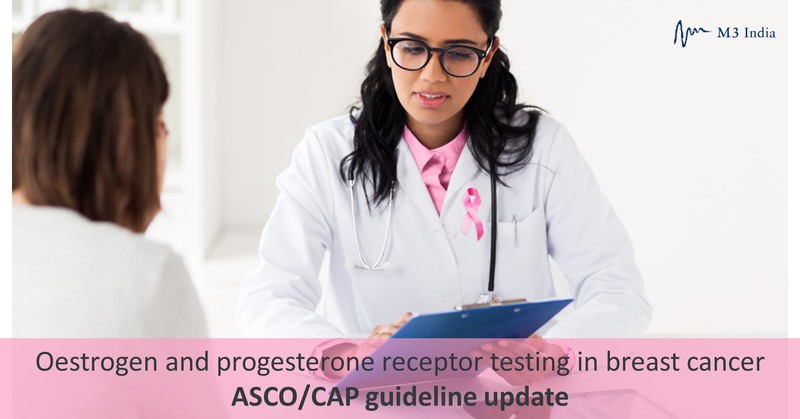Oestrogen and progesterone receptor testing in breast cancer: ASCO/CAP guideline update
M3 India Newsdesk Apr 07, 2020
The American Society of Clinical Oncology (ASCO) and College of American Pathologists (CAP) recently updated their guideline for oestrogen (ER) and progesterone receptor (PgR) testing in breast cancer. A multidisciplinary expert panel conducted a systematic review of the medical literature; below are the main recommendations from the updated guideline.
For our comprehensive coverage and latest updates on COVID-19 click here.

The American Society of Clinical Oncology (ASCO) and College of American Pathologists (CAP) recently updated their guideline for oestrogen (ER) and progesterone receptor (PgR) testing in breast cancer. As per the update, breast cancer samples with 1% to 100% of tumour nuclei-positive should be interpreted as ER-positive, while samples exhibiting 1% to 10% of cells staining ER-positive should be reported using a new reporting category – ER Low Positive. A sample is considered ER-negative if less than 1% or 0% of tumour cell nuclei are immunoreactive.
Determining potential benefit from endocrine therapy
Recommendation: Optimal Algorithm for ER/PgR Testing
- Samples with 1% to 100% of tumour nuclei positive for ER or PgR are interpreted as positive.
- For reporting of ER (not PgR), if 1% to 10% of tumour cell nuclei are immunoreactive, the sample should be reported as ER Low Positive with a recommended comment.
- A sample is considered negative for ER or PgR if <1% or 0% of tumour cell nuclei are immunoreactive.
- A sample may be deemed uninterpretable for ER or PgR if the sample is inadequate (insufficient cancer or severe artifacts present, as determined at the discretion of the pathologist), if external and internal controls (if present) do not stain appropriately, or if preanalytic variables have interfered with the assay’s accuracy.
For reporting a positive ER result, the threshold of ≥1% nuclear ER staining by immunohistochemistry (IHC) is recommended keeping in view the following points:
- Relatively low toxicity of endocrine therapy
- The desire to minimise false-negative results
- Evidence supporting potential benefit even in cases with as low as 1% to 10% positivity
Cases with 1% to 10% staining, however, have to be reported as “ER Low Positive” due to the heterogeneous behavior, and biology of this subgroup of ER-positive cancers.
Strategies that can promote optimal performance, interpretation, and reporting of IHC assays, particularly in cases with low to negative ER expression
- Recommendation: Laboratories should include ongoing quality control using SOPs for test evaluation prior to scoring (readout) and interpretation of any case as defined in the checklist given in the guideline.
- Recommendation: Interpretation of any ER result should include evaluation of the concordance with the histologic findings of each case. Clinicians should also be aware of when results are highly unusual/discordant and work with pathologists to attempt to resolve or explain atypical reported findings.
- Recommendation: Laboratories should establish and follow an SOP stating the steps the laboratory takes to confirm or adjudicate ER results for cases with weak stain intensity or ≤ 10% of cells staining.
- Recommendation: The status of internal controls should be reported for cases with 0% to 10% staining. For cases without internal controls and with positive external controls, an additional report comment is recommended.
For promoting optimal performance, interpretation, and reporting of cases with a low to no ER staining result, a laboratory-specific standard operating procedure describing additional steps used by the laboratory to confirm and adjudicate results is now recommended. As per the guidelines, cases with moderate-strong stain intensity and > 10% of cells staining are considered to have robust, reportable results as long as they are in agreement with histology. However, for cases with weak stain intensity or ≤ 10% of nuclei staining, additional steps should be taken to confirm or decide the validity of the results; additionally, correlation with histology is warranted.
As per the panel, the status of controls should be reported for cases with 0% to 10% staining due to the propensity of previously identified factors involved in false-negative results such as negative or absent internal controls. The assay should be deemed to be failed and requires troubleshot in the following cases:
- If internal controls are negative, or
- There are no internal controls, and the external positive controls do not have appropriate staining
Validated IHC is the recommended standard test for identifying patients likely to benefit from endocrine therapy
Recommendation: Validated IHC is the recommended standard test for predicting benefit from endocrine therapy. No other assay types are recommended as the primary screening test for this purpose.
At present, there is lack of sufficient data (especially from randomised clinical trials) to recommend newer methods of ER testing as alternatives to IHC for the purposes of determining ER status or selecting which patients are likely to benefit from endocrine therapy.
Though assays like Oncotype DX, Mammaprint, the Prosignia Breast Cancer Prognostic Gene Signature Assay, EndoPredict, and the Breast Cancer Index have established prognostic utility, there is insufficient data to back up their predictive utility, i.e., in identifying patients expected to benefit specifically from endocrine treatment.
ER testing for patients diagnosed with ductal carcinoma in situ (DCIS) without invasion
Recommendation: ER testing in cases of newly diagnosed DCIS (without associated invasion) is recommended to determine the potential benefit of endocrine therapies to reduce the risk of future breast cancer. PgR testing is considered optional.
The primary risk reduction options can be inferred based on the ER status of their DCIS. ER testing in DCIS can help guide discussions about adjuvant endocrine therapy. The ER status of newly diagnosed DCIS is recommended to be reported when no invasive cancer is present.
The PgR testing of DCIS is optional, as there are no data supporting the prognostic or predictive value of PgR testing in DCIS independent of ER.
-
Exclusive Write-ups & Webinars by KOLs
-
Daily Quiz by specialty
-
Paid Market Research Surveys
-
Case discussions, News & Journals' summaries